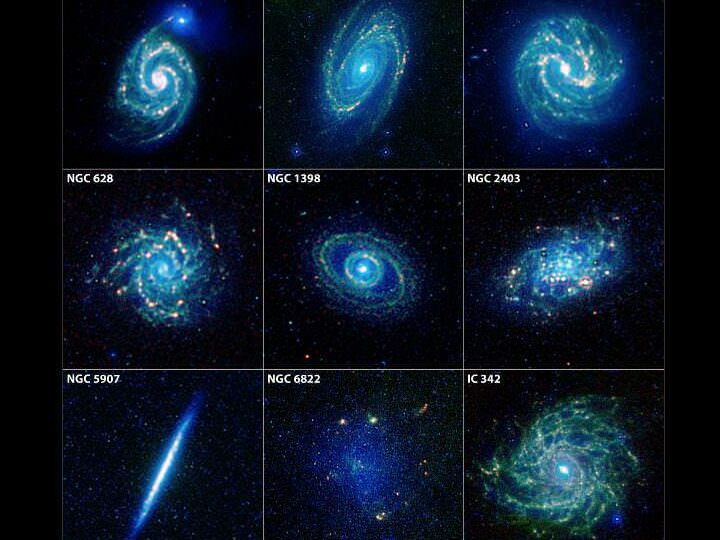- The spiral galaxy (abbreviated as S) is one of the primary forms of galaxies, a category of galaxies in the Hubble sequence that possesses the following physical characteristics:
* notable overall rotational momentum;
* composed of a central bulge (a nearly spherical thickening) encompassed by a disk:
* the bulge bears a similarity to an elliptical galaxy containing numerous ancient stars – the commonly referred to as “Population II” – and frequently a supermassive black hole positioned at the core;
The disk is a flat rotating structure made up of interstellar matter, young Population I stars, and scattered star clusters. Spiral galaxies get their name from the bright stellar arms that extend almost logarithmically out from the bulge. These arms are the main distinguishing feature between spiral galaxies and lenticular galaxies, which have a disk-like structure and lack a prominent spiral. Spiral arms are regions where active star formation occurs and are primarily composed of young, hot stars. This is why they are easily visible in the visible part of the spectrum. The majority of observed spiral galaxies rotate in the same direction as the twisting spiral arms.
A typical feature of a spiral galaxy is its disk, which is often surrounded by a large halo made up of old Population II stars. These stars are mainly concentrated in globular clusters that orbit the center of the galaxy. Therefore, a spiral galaxy is composed of a flat disk with spiral arms, an elliptical bulge, and a spherical halo that is similar in size to the disk.
In addition, it is common for spiral galaxies to have a bar in their center, from which spiral arms extend. These arms contain a significant amount of dust, gas, and star clusters. The material within them rotates around the galaxy’s center due to the force of gravity.
Recent observations, including those from the Spitzer Space Telescope in 2005 and years of radio astronomy research, have revealed that our own Milky Way galaxy is also classified as a spiral galaxy.
Similar concepts
An elliptical galaxy (designated as E) is a category of galaxies characterized by a distinct spherical (ellipsoidal) structure and a gradual decrease in brightness towards the outer regions. These galaxies are composed primarily of red and yellow giant stars, as well as red and yellow dwarf stars, with a few low-luminosity white stars. They lack blue-white giants and supergiants. Elliptical galaxies typically do not contain significant amounts of dusty matter, which, in other galaxies, appears as dark streaks against the backdrop of stars. This absence of dusty matter contributes to the elliptical shape of these galaxies.
The constellation Canes Venatici, also known as The Hound Dogs in Latin, is located in the northern hemisphere of the sky. It covers an area of 465.2 square degrees and contains 57 stars that can be seen with the naked eye. The best conditions for observing this constellation are in March and April. It is visible throughout Russia.
Galactica, which is derived from the Greek word γᾰλαξίας meaning “Milky Way” and the Greek word γάλα, γάλακτος meaning “milk”, is a system of stars, star clusters, interstellar gas and dust, dark matter, and planets that are gravitationally bound together. All objects within a galaxy are in motion relative to a central point of mass.
Pegasus, known in Latin as Pegasus, is a constellation located in the northern hemisphere of the night sky. It is situated southwest of Andromeda and covers an area of 1120.8 square degrees. Pegasus contains 166 stars that can be seen with the naked eye.
Mentions found in literature
Spiral galaxies, known as S-galaxies, have a distinct characteristic of having several spiral arms with irregular and wispy structures. These arms, although much smaller in mass compared to the spherical component of the galaxy, are easily distinguishable due to the presence of numerous young massive stars with high luminosity. These stars are continuously formed from concentrated clouds of interstellar gas and dust within the plane of the spiral arms. It is important to note that E-galaxies have significantly less interstellar gas content compared to S-galaxies, resulting in a lack of star formation in E-galaxies for a long period of time.
The Milky Way spiral galaxy can be described as a flat disk with a diameter of over 100,000 light-years and a relatively thin structure, measuring just a few thousand light-years in thickness. This disk exhibits an irregular formation, with its irregular structures originating from the core and extending towards the outer regions of the galaxy. These formations are commonly referred to as the “spiral arms” of our galaxy, which are areas of high matter density. It is within these spiral arms that the formation of new, young, and luminous stars takes place, starting from interstellar gas and dust clouds [1].
– The majority of nebulae in the sky consist of either spiral galaxies containing numerous stars or amorphous clouds of gas and dust. What we have witnessed is evidence of the utmost significance. “The DNA Nebula spans a length of approximately 80 light-years and is situated a mere 300 light-years away from the center of our Galaxy, where, based on current scientific theories, there should exist a supermassive black hole.” One of the potential explanations for the formation of this highly unconventional celestial object is the presence of a powerful magnetic field at the core of the Galaxy. This magnetic field is roughly three orders of magnitude stronger than Earth’s magnetic field. It is possible that the force lines of the magnetic field, aligned along the axis of the nebula, are responsible for this peculiar twist. The formation of such a nebula is a gradual process. The disk surrounding the black hole at the center of the Galaxy completes one revolution in approximately 10 thousand years. Interestingly, the observed “step” of the DNA double helix corresponds precisely to the ratio of the speed at which matter flows out and the speed at which it twists around a common axis.
Astronomers have made a remarkable discovery using telescopes that there exist millions of galaxies apart from our own. We are familiar with three main types of galaxies. The first type, known as spiral galaxies, have a similar shape to our very own Milky Way. The closest spiral galaxy to us is located approximately two million light years away and is an enormous entity situated in the Andromeda constellation.
Out of all the observed spiral galaxies, our galaxy represents a mere 5%, while the remaining 95% take on an elliptical or irregular form. In these galaxies, the formation of life is incredibly challenging, mainly due to the scarcity of heavy chemical elements and the presence of high levels of radioactive radiation.
Continuation of Related Concepts
Pisces, also known as the Fishes, is a large constellation that can be found between Aquarius and Aries in the zodiac. It is commonly divided into two parts: “northern Pisces,” which is located beneath the constellation Andromeda, and “western Pisces,” which lies between Pegasus and Aquarius.
Hydra, derived from the Greek word ύδρα and the Latin word Hydra, is a constellation that can be observed in the southern hemisphere of the sky. It is named after a creature from Greek mythology. The brightest star in Hydra is called Alfard and has a visual stellar magnitude of 2.0. The best visibility conditions for observing Hydra occur in February and March. It can be seen in its entirety in the southern regions of Russia and partially in the rest of the country.
The Hubble Posteriority is a classification system for galaxies that was originally proposed by Edwin Hubble in 1936. Although more detailed classifications have been introduced since then, the Hubble classification remains valid to this day.
Draco, also known as the Dragon, is a constellation that can be seen all year round in the Northern Hemisphere. It covers an impressive 1083 square degrees of the sky. The north pole of the ecliptic can be found within Draco, with equatorial coordinates R.A.=18h00m, Dec=+66°33'.
Hercules, or Heracles, is another constellation located in the northern hemisphere of the sky. It spans an area of 1225.1 square degrees and boasts 235 stars that are visible without the aid of a telescope. You can catch a glimpse of Hercules from anywhere in Russia. In the southern regions of Russia and the former USSR, the constellation reaches its highest point in the sky. The best time to observe Hercules is during the month of June.
Eridanus (Latin: Eridanus, Eri) is a constellation positioned in the southern hemisphere, and it is the sixth largest among the modern constellations in terms of its area. Extending from the celestial equator to a declination of -58°, Eridanus covers a vast area of 1137.9 square degrees in the night sky. This constellation is home to 187 stars that can be seen without the aid of a telescope.
Cetus (Latin: Cetus, Cet) is a celestial constellation located near the “water” region of the sky, in close proximity to the constellations Aquarius, Eridanus, and Pisces. It is easily visible in the central and southern regions of Russia. The months of October and November provide the best conditions for observing this constellation.
The constellation known as Indian, or Indus in Latin, stretches across the southern hemisphere of the sky. It can be located to the south of Microscope and Crane, extending all the way to Octanthus. Toucan lies to the west of Indian, while Telescope is found to the east, and Peacock to the southeast. Covering an area of 294 square degrees, Indian boasts 38 stars that can be seen without the aid of a telescope. In the late summer and early fall, the northernmost part of Indian can be observed low above the horizon in southern Russia, specifically south of latitude 44° 30′. In the southern region of Dagestan, under favorable conditions, Indian can also be seen.
Lynx, also known as Lyn in Latin, is a constellation that can be found in the northern hemisphere of the sky. Spanning an area of 545.4 square degrees, Lynx contains 92 stars that are visible to the naked eye. However, none of these stars are particularly bright.
Nasos, also known as Antlia in Latin, is a constellation that can be found in the Southern Hemisphere of the celestial sky. This particular constellation covers an area of approximately 238.9 square degrees and consists of 42 stars that can be seen without the aid of a telescope. Among these stars, there are 20 that shine particularly brightly with a magnitude of 6 or greater.
Furnace, or Fornax in Latin, is a relatively faint constellation located in the southern hemisphere of the sky. It spans an area of about 397.5 square degrees and contains a total of 57 stars that are visible to the naked eye.
Sextant, known as Sextans or Sex in Latin, is a small and inconspicuous equatorial constellation. It covers an area of approximately 313.5 square degrees in the sky and contains 34 stars that can be seen without the use of a telescope.
Giraffe (Camelopardalis, Cam) is a large constellation located in the northern hemisphere. It is primarily visible in Russia throughout the year, with the best viewing conditions occurring in January and February. The brightest star in Giraffe, β Giraffe, has a magnitude of +4.03m.
Irregular galaxies are a unique type of galaxy that does not conform to the traditional Hubble sequence. Unlike spiral or elliptical galaxies, irregular galaxies lack a distinct structure. They often have a chaotic shape without a well-defined nucleus or spiral arms. Irregular galaxies account for approximately one-quarter of all known galaxies and are believed to have originated from spiral or elliptical galaxies that were transformed by gravitational forces.
The peacock bird lends its name to the constellation Peacock (Latin: Pavo), which can be observed in the southern hemisphere of the celestial sphere. This constellation is visible in its entirety throughout the Southern Hemisphere and partially visible in the tropics of the Northern Hemisphere. However, it cannot be seen from Russia. Peacock is one of the 12 constellations that were identified by P. Plancius based on observations of the starry sky in the Southern Hemisphere conducted by P. D. Keyser. The depiction of Peacock first appeared on a 14-inch star globe created in 1598 by Plancius and J. Hondius in Amsterdam.
Serpens is a constellation that is located near the equator. It covers an area of 636.9 square degrees in the sky and has 106 stars that can be seen without the use of a telescope. The best time to see Serpens is in June, and it can be seen from anywhere in Russia. What makes Serpens unique is that it is the only constellation made up of two separate parts. The “Snake’s Head” is found in the northwest, while the “Snake’s Tail” is located to the east.
Sculptor, also known as Sculptor, Scl, is a constellation that can be seen in the southern hemisphere of the sky. It occupies an area of 474.8 square degrees and contains 55 stars that are visible to the naked eye. One interesting fact about the Sculptor constellation is that it is home to the South Pole of the Galaxy.
The Cancer constellation is not easily noticeable and can only be seen on a clear night between the Leo and Gemini constellations. The most prominent star in Cancer, known as β Cancer, has an apparent stellar magnitude of 3.53m.
A galaxy group is a collection of first-order galaxies (not to be confused with larger cosmic structures known as galaxy clusters). Typically, a galaxy group consists of no more than 50 objects, each with a brightness similar to that of the Milky Way galaxy. Our Milky Way is part of a galaxy group known as the Local Group. Galaxy groups typically have a diameter of no more than 2 megaparsecs and a mass of around 10 trillion solar masses, although there are larger groups of galaxies.
The Crane constellation, also known by its Latin name Grus, can be observed in the southern hemisphere of the sky. In Russia, it is only partially visible in the southern regions, specifically those located south of 53°N. One of the most prominent stars in this constellation is Alnair, which has a sidereal magnitude of 1.7. Alnair is located approximately 100 light-years away from Earth and is commonly used for astronavigation purposes. The Crane constellation is situated between the South Fish constellation in the north and the Tucana constellation in the south. It covers a total area of 365.5 square degrees in the sky and contains a total of 53 stars that can be seen with the naked eye.
The Telescope constellation, also known as Telescopium in Latin, is a relatively faint constellation found in the southern hemisphere of the sky. It encompasses an area of 251.5 square degrees and consists of 50 stars that can be seen without the aid of a telescope.
Located in the northern hemisphere of the sky, the Triangle constellation, or Triangulum in Latin, spans across an area of 131.8 square degrees. This constellation contains 25 stars that are visible to the naked eye.
The Crater constellation, also known as Bowl (Latin Crater, Crt), is located in the southern hemisphere of the sky. It covers an area of 282.4 square degrees and consists of 20 stars that can be seen with the naked eye.
The Local Galactic Group is a group of galaxies that are gravitationally bound together. It includes the Milky Way, the Andromeda Galaxy (M31), and the Triangle Galaxy (M33).
A star cluster is a group of stars that are gravitationally bound and share a common origin. These clusters move together within the galaxy’s gravitational field. Some star clusters also contain clouds of gas and/or dust.
An LSB galaxy, short for low-surface-brightness galaxy, is a type of diffuse galaxy. These galaxies have a surface brightness that is dimmer than the surrounding background sky by at least one unit of apparent stellar magnitude when observed from Earth.
The New General Catalogue of Nebulae and Clusters of Stars (NGC) is widely recognized as the most popular catalog among amateur astronomers for identifying distant celestial objects.
Lepus, also known as Zajac in Latin, is a constellation located in the southern hemisphere of the night sky. It covers a vast area of 290.3 square degrees and includes a total of 72 stars that can be seen without the aid of a telescope. It is particularly well-observed in central and southern regions of Russia and offers optimal viewing conditions during the month of December.
A Seyfert galaxy is a type of galaxy that displays an active nucleus, characterized by a distinctive emission spectrum consisting of bright broad bands. These bands indicate the presence of highly energetic gas emissions, often with velocities reaching several thousand kilometers per second. Carl Seyfert first described such galaxies in 1943, and they represent approximately 1% of all observed spiral galaxies.
The Lacerta, which is also known as the Lizard, is a constellation that can be found in the northern hemisphere of the sky. Situated between the Swan and Andromeda constellations, it does not have any particularly bright stars, even though its northern half is positioned within the Milky Way. The brightest star within Lacerta has a visual sidereal magnitude of 3.8. This constellation covers a total area of 200.7 square degrees in the sky and is home to 63 stars that can be seen without the aid of a telescope.
Naugol (also known as Norma) is a constellation located in the southern hemisphere of the night sky. It can be found southwest of Scorpius and north of the Southern Triangle, with Circulus touching its border. While both branches of the Milky Way pass through this constellation, it is not particularly rich in bright stars. In fact, there are no stars in Naugol that have a visual sidereal magnitude brighter than 4.0. However, there are still 42 stars that can be seen without the aid of a telescope, and the constellation covers an area of 165.3 square degrees in the sky. The best time to observe Naugol is during the months of May and June, and it can be partially seen in southern Russia if you are located south of 48 N.
Tucan (also known as Tucana or Tuc) is another constellation in the southern hemisphere of the night sky. It spans an area of 294.6 square degrees and contains 44 stars that can be seen without the aid of a telescope.
A peculiar galaxy is a unique galaxy that does not fit into any specific category in the Hubble sequence due to its distinctive characteristics. There is no clear definition for this term, and the classification of galaxies as peculiar can be subject to debate.
An open cluster is a collection of stars, ranging from a few to several thousand, that form from a single massive cloud of gas and dust and are approximately the same age. Our Galaxy has over 1100 known open clusters, but it is believed that there are many more yet to be discovered. The stars within these clusters are loosely bound by gravitational forces, making them susceptible to disruption as they orbit the center of the galaxy.
Perseus (Latin: Perseus) is a group of stars in the northern part of the sky, named after a famous figure from Greek mythology who defeated the Gorgon Medusa. It is one of the 48 constellations identified by Ptolemy and recognized by the International Astronomical Union as one of the 88 modern constellations. Perseus is home to Algol (β Per), a well-known variable star, and serves as the radiant for the annual Perseid meteor shower.
Galaxy clusters are massive collections of galaxies that are held together by gravity. They are among the largest structures in the Universe.
A galaxy cluster is a compact assemblage of stars, containing several billion celestial bodies (which is quite modest in comparison to our own galaxy, the Milky Way, which boasts an impressive 200-400 billion luminous entities). Dwarf galaxies, on the other hand, are cosmic entities with a radiance of less than 109 L☉ (about a hundred times dimmer than the Milky Way’s luminosity), equivalent to an absolute stellar magnitude of approximately -16m. The Large Magellanic Cloud, encompassing a staggering 30 billion stars, is occasionally classified as a dwarf galaxy, although there are those who hold a different perspective.
Aries is a well-known constellation in the zodiac, even though it does not have any stars brighter than second magnitude. The three main stars, Hamal (“head of the ram”), Sheratan (“mark” or “sign”), and Mezartim (α, β, and γ of Aries respectively), are easily identifiable as they are located south of the Triangle. Mesartim, a fourth magnitude star, was one of the first double stars discovered using a telescope, credited to Robert Hooke in 1664.
The Eagle constellation (Latin: Aquila) is situated along the celestial equator. Its western section can be found in the eastern part of the Milky Way, to the south of the Arrow constellation. The total area of the Eagle constellation is 652.5 square degrees, and it contains 70 stars that are brighter than 6m.
Lyra (gudge. લેયરા , Lat. Lyra, Lyr) is a small constellation located in the northern hemisphere, positioned between Hercules and Swan.
Continuation of references in literature
The literature makes mention of spiral galaxies and their composition. The branches of these galaxies consist of hot stars, specifically supergiants, which emit radio waves. A notable characteristic of spiral galaxies is that they rotate at extremely high speeds. In fact, approximately ten percent of the total mass of a spiral galaxy is comprised of neutral hydrogen.
One particular spiral galaxy, located a mere two million light-years from us, stands out as the closest neighbor to our own Milky Way galaxy. This large galaxy boasts a flattened spinning disk that spans about 200,000 light-years and contains several hundred billion star systems, along with gas and dust clouds.
Our galaxy, the Milky Way, is a classic spiral galaxy similar to the one depicted in the image above. It contains around 200 billion stars and has a diameter of approximately one quintillion kilometers… However, in the field of astronomy, cosmic distances are not typically measured in kilometers. The kilometer unit is considered too small for such vast distances. Even astronomical units, which we discussed earlier and are not commonly used, are still too small. (Just as a reminder: an astronomical unit is equal to 150 million kilometers, which is the distance from the Earth to the Sun.) Astronomers prefer to measure distances in light-years and parsecs.
“When astronomers measured the velocity at which the Andromeda Nebula, a massive spiral galaxy twice the size of our own, was moving, it appeared to be approaching us. On a cosmic scale, it is approaching us at an astonishing speed of 120 kilometers per second.”
The Andromeda Nebula is the nearest spiral galaxy to our own galaxy. It is currently approaching us at a speed of 110 kilometers per second and is projected to collide with the Milky Way in approximately 4 billion years. However, there is no need to be alarmed as we still have ample time before this event occurs!
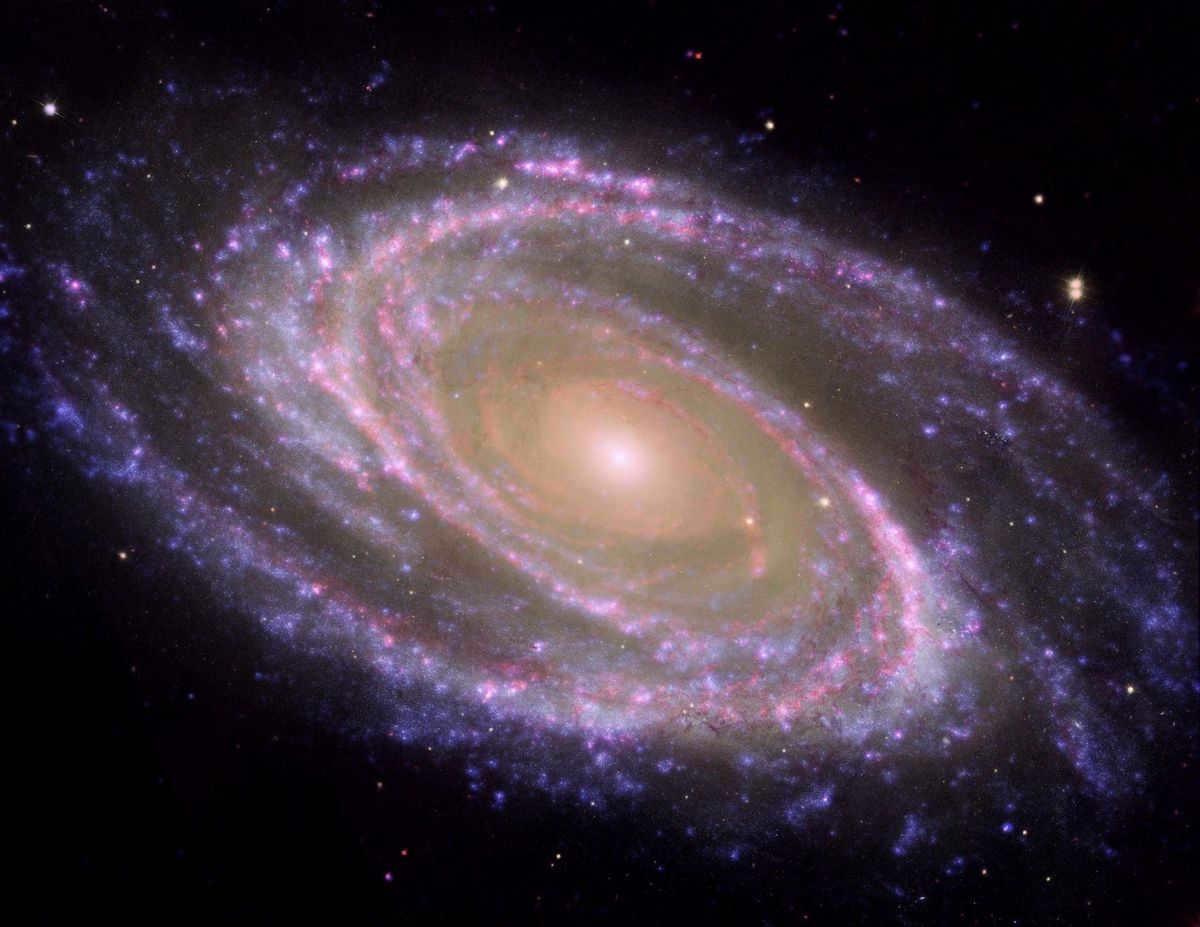
There exists a wide variety of galaxies in the vast expanse of the observable universe. Among them resides a peculiar entity known as the spiral galaxy. This entity represents an immense congregation of disk-shaped stars, adorned with arms that twist and turn, resembling the graceful blades of a windmill. The configuration of these arms exhibits a delightful array of patterns, yet they all share a common feature – a dense core from which these spirals gracefully extend. Given the prevalence of spiral galaxies, accounting for close to 60% of all known galaxies, it is only fitting that we delve into a comprehensive exploration of their characteristics.
Within the confines of this article, we shall embark on an enlightening journey, unraveling the intricacies of the spiral galaxy and acquainting ourselves with its defining traits.
Main features
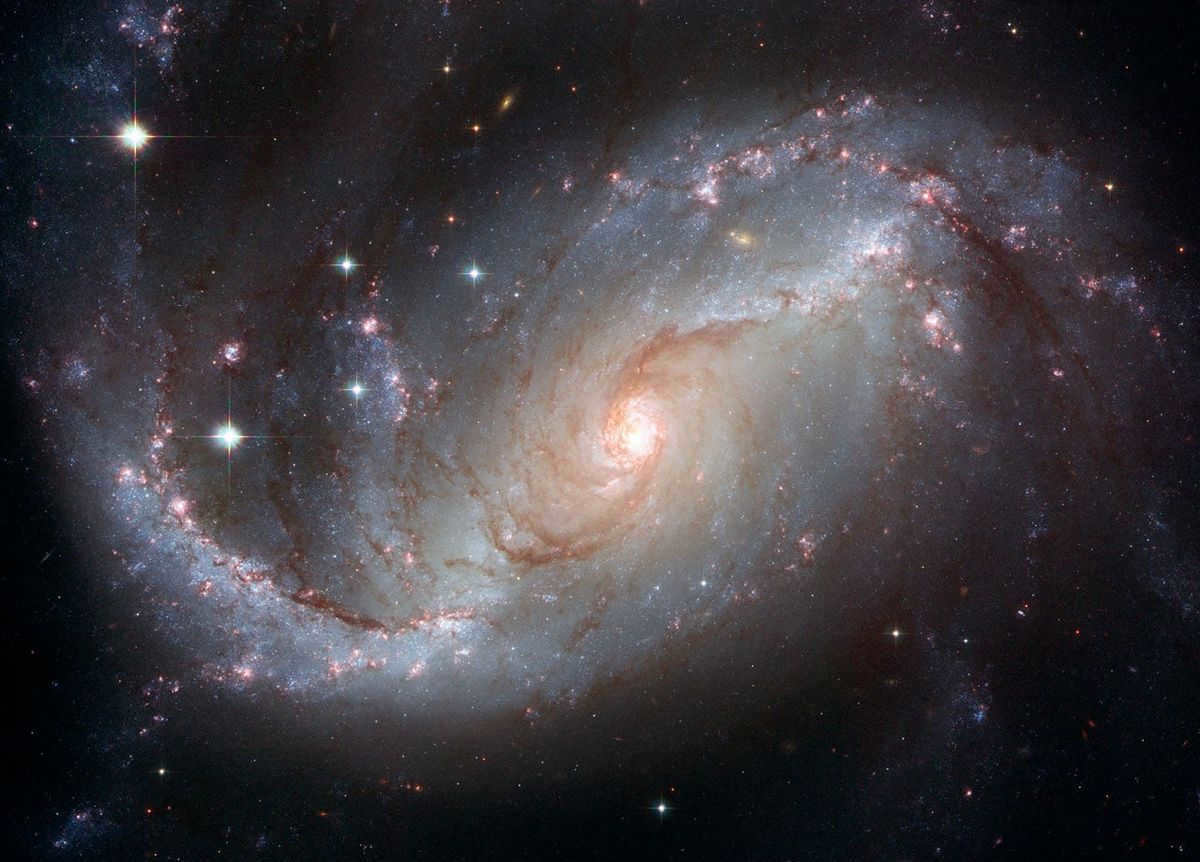
Approximately two-thirds of spiral galaxies possess a central structure known as a jumper spiral galaxy, which distinguishes them from their simpler counterparts. These jumper spiral galaxies feature only two spirals that originate from the central bar and rotate in the same direction. The Milky Way is an example of this type of spiral galaxy. The central bulge of these galaxies is characterized by a reddish hue, which is attributed to the presence of older stars. Additionally, there is a limited amount of gas located in the galaxy’s center, and it typically contains a black hole.
In addition to its disk, a spiral galaxy is also surrounded by a spherical halo made up of small amounts of gas and dust. This halo is home to ancient stars, which are gathered together in globular star clusters. These clusters are massive collections of stars, with billions of stars moving at incredible speeds.
Various Categories of Spiral Galaxies
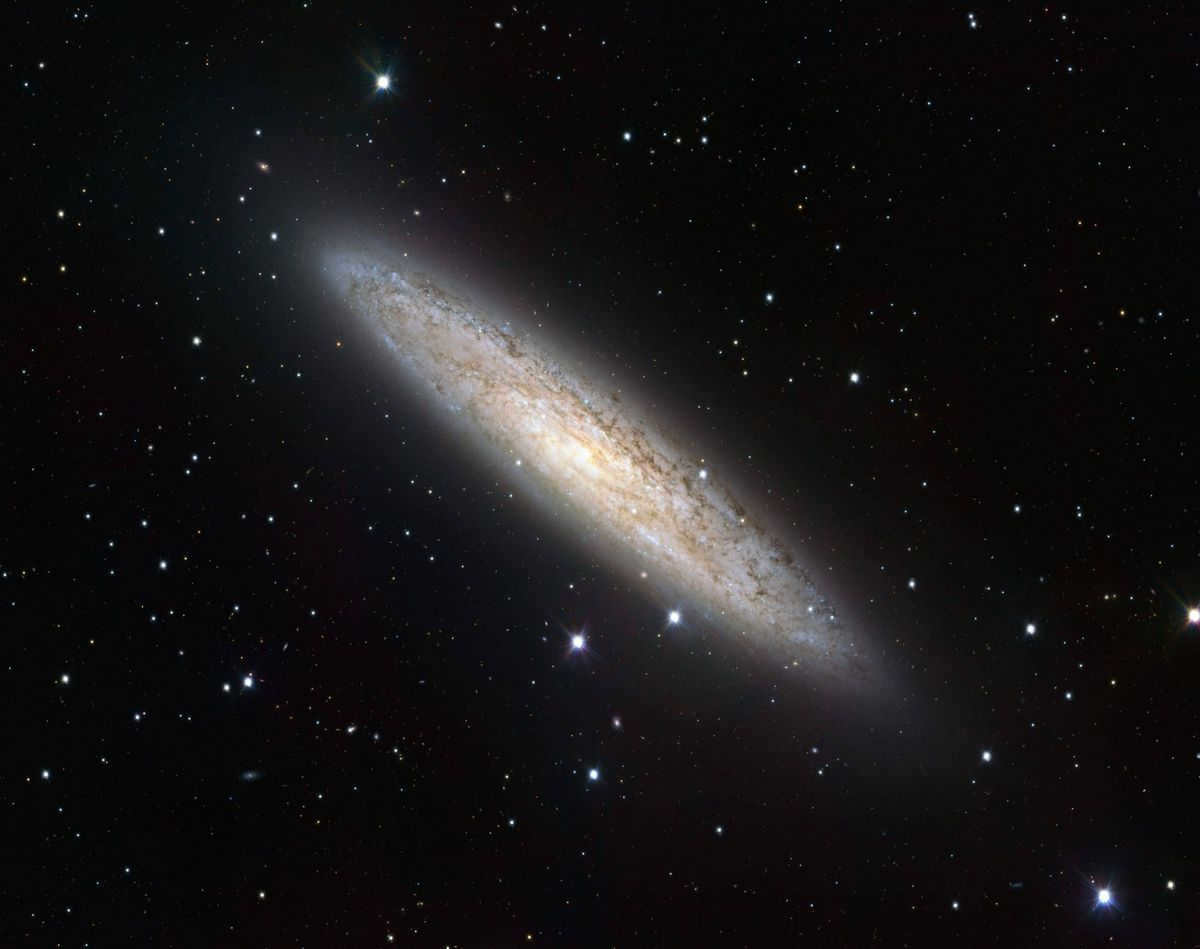
As we have previously stated, spiral galaxies come in various forms, which are determined by the configuration of their arms and the makeup of their interiors. In order to classify these galaxies according to their morphology, Edwin Hubble devised a classification system. This system was subsequently refined by other astronomers who introduced additional characteristics and new classifications.
Hubble classified galaxies using a coding system, with E representing elliptical galaxies, SO representing lenticular galaxies, and S representing spiral galaxies. As more information became available, additional categories were introduced, such as SB for spiral galaxies with a bar, and Irr for galaxies with irregular shapes. Approximately 90% of all observed galaxies have an elliptical or spiral shape, while only 10% fall into the Irr category.
Our own galaxy, the Milky Way, is classified as a type SBb. The Sun resides in one of the spiral arms known as Orion. This arm derives its name from the stars belonging to the Orion constellation, which is one of the most prominent constellations visible from Earth.
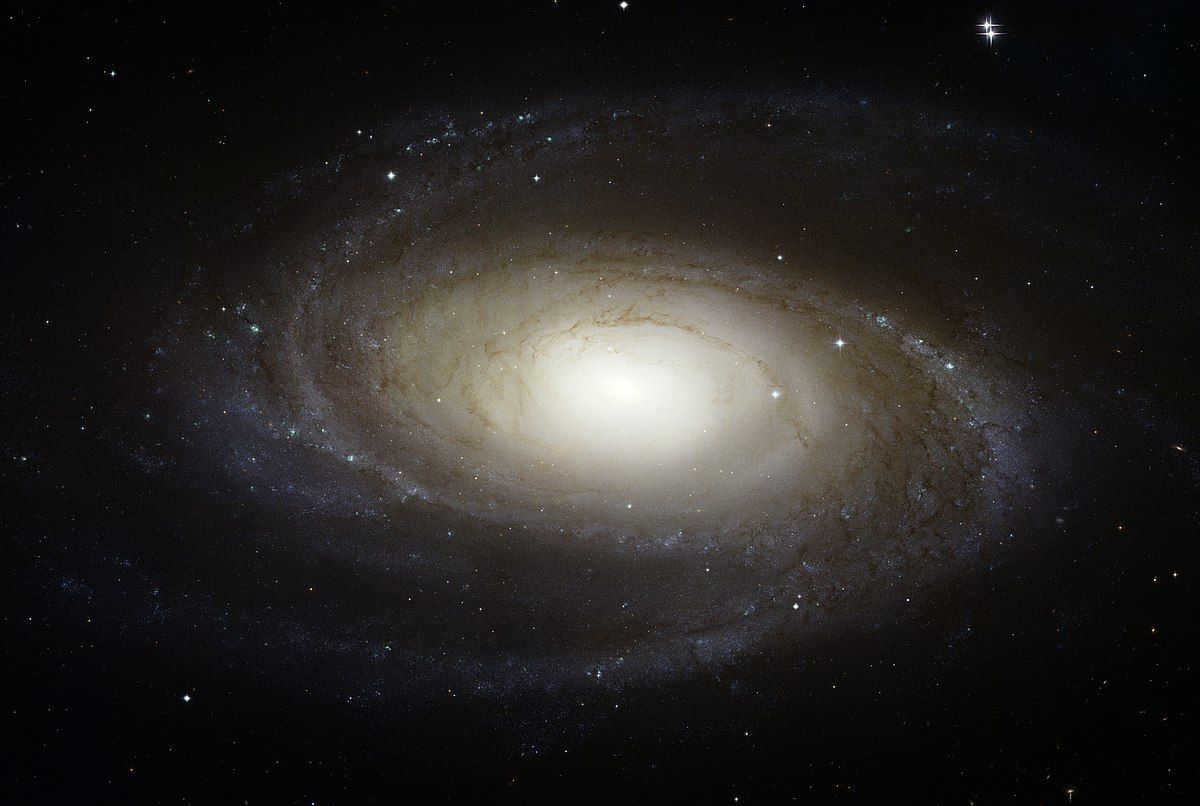
The exact origin of the spiral galaxy remains unknown, although there are several theories surrounding it. One observation made by astronomers is that the various structures within a spiral galaxy rotate at different speeds, a phenomenon known as differential rotation. This unique characteristic is thought to play a role in the formation of the spiral arms. The inner disk of the galaxy experiences faster rotation compared to the outer regions, while the spherical halo does not rotate at all. This discrepancy in rotation speeds has led to the proposal of dark matter as a possible explanation.
If this hypothesis holds true, it suggests that spiral galaxies may have a relatively short lifespan. Specifically, the spirals would gradually wind up upon themselves and eventually dissipate.
Distinguishing Characteristics of Spiral Galaxies
An elliptical galaxy can sometimes be mistaken for a spiral galaxy, but there are several key differences between the two. One major distinction is the distribution of stars. In an elliptical galaxy, stars are evenly spread out, while in a spiral galaxy, stars are concentrated in reddish disks and scattered in spiral arms. Additionally, when examining the arrangement of stars in an elliptical galaxy, it becomes apparent that it has an oval shape.
Another distinguishing factor is the presence of interstellar gas and dust. Elliptical galaxies have mostly converted their matter into stars, resulting in minimal amounts of gas and dust. Conversely, spiral galaxies contain regions where new stars form from the gas and dust present. These areas are more prevalent in spiral galaxies.
One way we can differentiate between these galaxies is by examining the noticeable contrast in the quantity of stars. Astronomers classify the stellar population based on age. Elliptical galaxies consist of older stars and various elements that are heavier than helium. On the other hand, when we examine spiral galaxies, we observe that they consist of both young and old star populations. However, the younger populations with a higher level of metallicity are predominantly found in the disk and arms. This indicates that they have a higher concentration of heavy elements and remnants of stars that have already vanished. Conversely, the spherical halo contains the oldest stars.
I trust that this information will allow you to gain a better understanding of spiral galaxies and their characteristics.
The information presented in this article is in line with our editorial ethics guidelines. If you notice any inaccuracies, please click here to report them.
Summary of the Full Article: Network Meteorology “astronomy” Spiral galaxy
The categorization of galaxies based on their appearance is known as morphological classification. Astronomers and researchers use various schemes to classify galaxy types according to their morphology. One of the most renowned and significant schemes is the Hubble sequence, which was originally formulated by Edwin Hubble and later expanded by Allan Sandidge and Gerard Vaucouleurs.
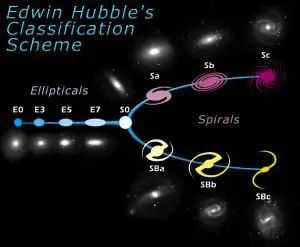
Categories of galaxies
In the field of astronomy, both professional and amateur, the Hubble sequence is employed to categorize various types of galaxies.
The Hubble diagram classifies conventional galaxies into three general categories:
Spiral galaxies
Spiral galaxies are a cluster of stars and gas that appear as a spinning disk with a central bulge encircled by flat rotating arms. The majority of the galaxies found to date are spiral galaxies. This rotational movement can reach velocities of several hundred kilometers per second. The observable central bulge consists of fainter and more mature stars, and is commonly believed to house a supermassive black hole.
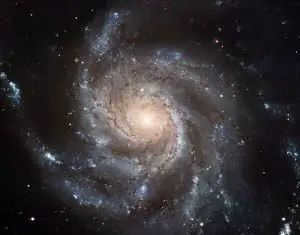
Approximately two-thirds of spiral galaxies exhibit a rod or straight arm configuration that extends through their central region. Prior to forming a spiral spinning disk around the central bulge, stars align within the bar. These spiral arms, which contain substantial quantities of gas and dust, are responsible for the generation of new stars. These youthful stars emit intense light but have a short lifespan. These particular galaxies are classified as Jumper spiral galaxies. The Milky Way is an outstanding example of this type of spiral jumper galaxy.
The origin of spiral arms continues to baffle scientists.
One theory proposes that spiral arms may arise from density waves that propagate through the outer disk of galaxies. Interactions between galaxies can generate such density waves, as the mass of a smaller galaxy disrupts the density and structure of a more massive galaxy during a merger.
The vast majority of spiral galaxies have a rotation pattern where their arms follow the direction of the galaxy’s rotation. Measurements of spiral curves have revealed that the orbital velocity of the matter in the disk is consistent with the estimate if the majority of the mass is concentrated near the center. This is why the visible portion of spiral galaxies is believed to account for only a small fraction of the total galactic mass. A significant portion of spiral galaxies contain a large halo made up of dark matter.
Spiral galaxies classification
Spiral galaxies are classified based on the tightness of their spiral, the size of their central bulge, and the irregularity of their arms. The presence of gas and dust in these galaxies also impacts their structure.
At present, there are three classifications of classical spiral galaxies and junction spiral galaxies:
1. Spiral galaxy of type A – [Sa]-. This kind of galaxy features a prominent central bulge with wide spiral arms. About 2% of the galaxy’s mass
2. Spiral galaxy of type B – [Sb]-. This type of galaxy has a moderately sized central bulge and moderately pronounced spiral arms.
3. Spiral galaxy of type C – [Sc] -. A galaxy of this type has a small central bulge and thin but well-defined spiral arms.
4. Type A spiral galaxy with a junction – [SBa] – [SBa] – This type of galaxy has strongly connected arms.
5. Type B jumper spiral galaxy – [SBb] – This type of galaxy has arms that are firmly and easily connected.
6. Spiral galaxy with jumper type C – [Sbc] -. This classification refers to a spiral galaxy with arms that are slightly connected.
As time passes, spiral galaxies have a tendency to transform into elliptical galaxies. However, it is important to note that not all elliptical galaxies originated from spiral galaxies. Over time, these galaxies undergo various changes in their morphology, size, and composition. Spiral galaxies, which are predominantly found in galaxy clusters with low density, have the potential to merge with other galaxies or evolve into elliptical or lenticular galaxies.
2. Elliptical galaxies
Elliptical galaxies are vast elongated-spherical galaxies that encompass billions of stars. These galaxies appear as hazy patches of light in the nighttime sky.
The category of elliptical galaxies exhibits a broad spectrum of dimensions and masses. The tiniest dwarf elliptical galaxies are situated a mere few hundred light-years away and are only slightly larger than globular clusters. On the other hand, the most colossal elliptical galaxies have a diameter of hundreds of thousands of light-years. These galaxies can house a trillion or more stars compared to the Milky Way.
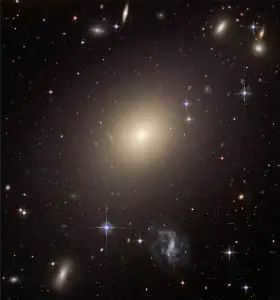
Elliptical galaxies represent one of the most ancient creations in the entire Universe. Inside their uniform halos, these galaxies exist in a relatively dormant state when compared to their spiral counterparts. In the majority of elliptical galaxies, the processes of star formation remain inactive. Moreover, the presence of gas and dust within these galaxies is minimal.
At the core of these galaxies resides a supermassive black hole that has formed as a result of the demise of massive, elderly stars.
Older elliptical galaxies lack interstellar gases. According to computer simulations, these galaxies are the outcome of collisions and mergers between other galactic entities.
When two spiral galaxies collide, a significant amount of the gas and dust within them is exposed and expelled into the surrounding intergalactic space. As a result, the remaining material undergoes rapid compression, triggering a burst of star formation known as a star formation explosion. This influx of young stars consumes the galaxy’s reserves of gas through supernovae and powerful stellar winds, which in turn carry gas and dust clouds out into the depths of space.
For elliptical galaxies that are in the process of growing, the dense regions of the Universe, where galactic collisions occur frequently, serve as fertile breeding grounds. These elliptical galaxies are typically found at the heart of dense galaxy clusters, with spiral galaxies situated along the periphery.
3. Lenticular galaxies
Lenticular galaxies are named as such due to their resemblance to lenses when viewed from the side. These galaxies are also referred to as armless disks or armless spirals. Lenticular galaxies represent a unique stage in Hubble’s classification of galaxies. They illustrate the transition of galaxies from elliptical to spiral forms. Lenticular galaxies are occasionally mistaken for spiral or elliptical galaxies when observed from different perspectives.
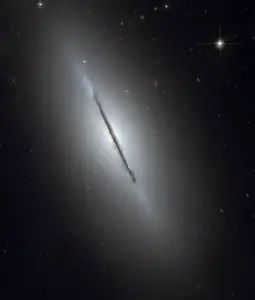
Similar to spiral galaxies, galactic lensing systems possess a disk, a central bulge/nucleus, and a galactic halo. Some lenticulars also exhibit galactic interstices and even rings of star formation. However, lenticular galaxies always lack spiral arms. This could be due to their limited star formation occurring outside the central region. Lenticular galactic systems have a scarcity of gas and dust, which results in an old stellar population, much like elliptical systems.
There are two different explanations for the origin of lenticular galaxies.
One hypothesis proposes that lenticular elements may also arise from fusion. This idea is supported by the presence of larger central protrusions compared to most spirals. It is well-known that, following a merger, most stars tend to reposition themselves within the central region of the galaxy.
Unconventional galaxies
An unconventional galaxy is a term used to describe any galaxy that does not neatly fit into the established Hubble classification system. These galaxies lack a distinct shape or structure. They are often formed through collisions, direct interactions with other galaxies, or intense internal activity. Unconventional galaxies encompass both older and younger galaxies, featuring a significant number of stars, substantial amounts of dust and gas, and typically exhibiting active star formation in bright bulges.
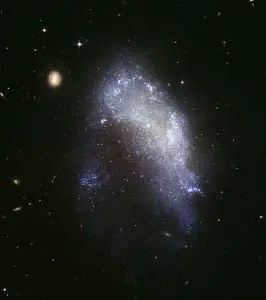
These spiral galaxies have different shapes, sizes, luminosities, ages, compositions, and more. The Milky Way’s closest neighbors are irregular galaxies.
The significance of classifying galaxy types
Classifying galaxy types helps us gain a deeper understanding of the vast universe and the origins of everything. (Literally!)
In the field of astronomy, elliptical and lenticular galaxies are often referred to as “early-type” galaxies because they are known to contain some of the oldest stellar populations and have relatively low levels of new star formation.
On the other hand, “late-type” galaxies, such as spiral and irregular galaxies, are characterized by their ongoing star formation and relatively small populations of older stars.
While Hubble’s sequence is a valuable tool, it is not without its flaws and criticisms. Some of the issues it has faced include:
- The subjective nature of the Hubble sequence means that different astronomers may classify the same galaxy into different groups.
- The use of two-dimensional images of galaxies for classification can be problematic, as it may not account for variations in orientation. The appearance of galaxies can change when viewed from different angles.
- The classification of galaxy types heavily relies on visual factors, making it a challenging task to classify distant and faint galaxies.
Despite these challenges, the Hubble sequence has made significant contributions to the categorization of galaxy types.
Figure 1. The Andromeda Galaxy, also known as M31, stands as the nearest spiral galaxy to our own. Its close proximity allows for detailed study of its structure, including the observation of spiral arms, blue gas and dust clouds where stars form, and a bright core containing a high concentration of old and low-mass stars. The galaxies discussed in the paper are 5-7 times larger than the Andromeda Galaxy and exhibit a star formation rate 60-70 times greater. Image from space.com
Galaxies emerge, develop, and perish. Through collisions and the acquisition of gas from the surrounding environment, they ignite supermassive black holes at their cores, deplete their gas reserves, heat up and cool down, undergoing drastic transformations. We now possess an exponentially greater understanding of galaxies compared to Edwin Hubble, the discoverer of galaxies. One of the main objectives of modern astrophysics is to formulate a comprehensive theory of galaxy evolution, elucidating the birth and future transformation of each individual galaxy. A recent study conducted by American astronomers, which focuses on the identification of 53 exceptionally bright and massive spiral galaxies, may contribute to bridging one of the gaps in this theory. Despite their enormous mass, these galaxies exhibit ongoing active star formation, making them prime candidates for the theoretically predicted transitional phase between spiral and lenticular galaxies.
Galaxies of a new type challenge existing theories
A team of astronomers from the California Institute of Technology (USA) have discovered 53 exceptionally bright spiral galaxies. These galaxies emit optical light that is 10 times brighter than our Milky Way and comparable to the most luminous elliptical galaxies. The size of these galaxies is also remarkable, ranging from 57 to 134 kiloparsecs (equivalent to up to 400,000 light-years). Additionally, their stellar mass is up to 3.4-10^11 times that of our Sun, making them 5-6 times larger than the Milky Way. These unique characteristics, combined with their high rate of star formation (ranging from 5 to 65 solar masses per year), distinguish these spiral galaxies from others in the universe.
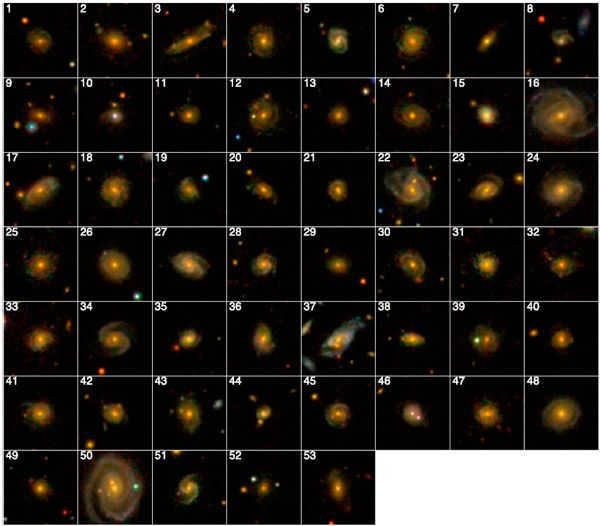
Figure 2. Portraits of all 53 extremely bright galaxies are displayed in this image. The researchers highlight distinctive characteristics in several of them: 1 – a spiral galaxy with multiple arms, 8 – an asymmetrical spiral galaxy with two arms, 10 – featuring a quasi-stellar object (QSO), which is a celestial body that resembles a star but is located at a great distance from us, resulting in its tremendous luminosity, 21 – a galaxy with a ring-shaped structure, 23 – potentially exhibiting an arm that has been deformed by tidal forces, 33 – an irregular disk galaxy, 34 – potentially possessing a secondary bulge, 53 – likely displaying discontinuous arms. This image is sourced from the article discussed in The Astrophysical Journal
There is a general consensus now that galaxies can be categorized into two primary groups: blue disk galaxies, or Late Type Galaxies (LTG), and red, “dead” elliptical galaxies, also known as Early Type Galaxies (ETG). In blue disk galaxies, star formation is typically active, while in red elliptical galaxies, the formation of new stars is extremely rare. The ETG galaxies are usually ellipsoidal in shape and significantly more massive than the disk galaxies. Within the disk galaxies, there are spiral galaxies, such as the Milky Way and the neighboring Andromeda Galaxy, where star formation occurs in their arms. On the other hand, there are lenticular galaxies, also referred to as lenticular galaxies, which lack a distinct spiral structure and have a lower occurrence of star formation.
Empirical data indicates that the total mass of the stellar population in disk galaxies, where star formation is still occurring, never exceeds 5-10 10 solar masses. As the gas reservoirs deplete and the rate of star formation diminishes, these galaxies gradually transition into early-type galaxies. This transformation typically spans approximately one billion years. The precise mechanisms and primary factors driving the evolution of galaxies remain subjects of ongoing debate.
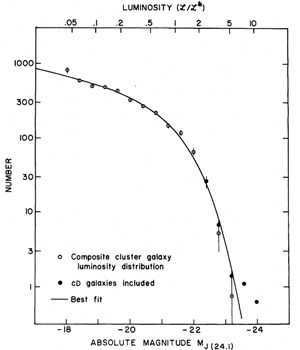
Figure 3. The Schechter function illustrates the density of galaxies in the Local Universe on the vertical axis and the absolute stellar magnitude (which is closely related to mass) on the horizontal axis. This function reveals that there is a large number of small galaxies and only a few large ones. P. L. Schechter provided a numerical interpretation of the distribution of galaxies in his paper titled “An analytic expression for the luminosity function for galaxies” published in 1976.
Astrophysicists are fascinated by the ability of ultrabright spiral galaxies to continue forming stars at a rapid pace even after reaching a massive stellar mass of 100 billion (10 11 ) solar masses. Understanding the mechanisms that prevent these galaxies from “dying” and transitioning into old red lenticular or elliptical galaxies is crucial for unraveling the mysteries of galactic evolution.
What was the process of their discovery?
Typically, the detection of these exceptionally luminous spiral galaxies was an unintended outcome of an unrelated endeavor, and it didn’t necessitate any additional astronomical surveys: all the photometric information, along with the galaxies’ distances, had already been released and made accessible to the public!
Caltech’s Patrick M. Ogle and his team undertook a project to verify the accuracy of data within the NASA/IPAC Extragalactic Database (NED), which serves as the largest collection of images, photometry, and spectra of galaxies from surveys conducted across various bands of the electromagnetic spectrum – microwave, infrared, optical, and ultraviolet (UV). The primary objective of this project was to assess the completeness of the data, enabling a better understanding of the size and luminosity requirements for galaxies to be visible at different distances. Conversely, this assessment also helps determine the maximum distance at which a galaxy with specific characteristics can still be observed using existing telescopes. Such evaluation is crucial to identify any biases in the statistical distribution of galaxies based on attributes such as color, mass, morphology, and other parameters. By doing so, it becomes possible to assess whether the absence of faint, small galaxies at high redshifts is due to their nonexistence (due to inadequate time for their formation or unsuitable environmental conditions) or simply a result of limitations in our current telescopes.


Figure 4. Pictures of one of the extremely bright spiral galaxies (identified as galaxy number 16 in Fig. 2) captured in various segments of the electromagnetic spectrum. From left to right: captured in the ultraviolet range by the GALEX UV space telescope, captured in the optical range by the Sloan Digital Sky Survey (SDSS), the two right images captured in the infrared range by the 2MASS survey and the WISE space infrared telescope. Image from the article discussed in The Astrophysical Journal
Consequently, Ogle’s team made a discovery that within a redshift of z ~ 0.3 (equivalent to a distance of no more than 3.5 billion light-years), the Sloan Digital Sky Survey (SDSS) observes all galaxies that are approximately 8 times brighter or more than our Milky Way. There are a total of 797,729 galaxies that meet this criteria. Out of sheer curiosity, 1616 of the brightest galaxies were selected. The team took into consideration the impact of dust, which diminishes optical radiation, and eliminated galaxies that appeared faint in the UV range (as the presence of UV radiation indicates active star formation). Surprisingly, some of these galaxies were identified as spiral galaxies, which was a significant revelation as researchers had never encountered such brilliantly luminous spiral galaxies previously. These 53 galaxies were distinguished as a distinct group and became the focal point of a separate investigation.
What makes them so fascinating?
These galaxies have captivated scientists due to their unique characteristics. The mass of these galaxies was calculated using a well-established relationship that correlates the mass and luminosity of spiral galaxies. The results obtained from optical and microwave telescopes showed a remarkable consensus, indicating that the stellar masses of these galaxies fall within the range of 30 to 340 billion solar masses.
To further explore these galaxies, researchers employed a method proposed in the paper by Y.-Y. Chang et al., 2015, titled “Stellar Masses and SFRs for 1M Galaxies from SDSS and WISE.” This method involved determining the star formation rate in these galaxies by analyzing the infrared emission detected by the WISE telescope. However, one of the challenges faced in this analysis is that young massive stars emit most of their radiation in the UV range, according to Wien’s displacement law. While this UV radiation could be a strong indicator of star formation, it is essential to consider other potential sources, such as ionized hydrogen, that also emit UV radiation.
1) The radiation from supermassive black holes at the centers of these galaxies might not be strong enough to heat up and disperse the gas in the star-forming regions, which is a common way for stars to stop forming in galaxies. Six galaxies, classified as Seyfert galaxies, showed signs of active galactic nuclei, suggesting a rapid growth in the supermassive black hole’s mass. Typically, the more active these nuclei are, the slower the rate of star formation, but that’s not the case in our situation – and this is another unique characteristic of extremely bright spiral galaxies.
2) It is not yet clear why a considerable quantity of cold hydrogen was initially collected in the galaxy’s disk and has not been depleted despite the sustained high rate of star formation over billions of years. The article does not present arguments supporting or refuting this hypothesis, but it is theoretically possible.
3) Galaxies continuously exert gravitational pull on various types of galactic debris, including gas. As a result, it is logical that their mass increases over time, and newly accumulated gas can serve as fuel for the ignition of new stars. However, during the process of accretion onto a galaxy, the gas undergoes collisions with the halo, which is the outer layer composed of the same gas, dust, and small particles. These collisions lead to the heating of the gas, causing its atoms to move at high speeds. Consequently, the heated gas is unable to undergo star formation, as its atoms are moving too rapidly (refer to: Jeans mass and star formation processes). This collision is referred to as an accretion shock wave, and its occurrence inhibits star formation since only cold gas can be compressed by gravity to form dense protostars. This brings us to the third scenario for continuous star formation in extremely bright galaxies: the mass of their halos is insufficient to heat the incoming gas.
What led to their emergence and what lies in store for them in the future?
When it comes to the causes behind the formation of such galaxies, astronomers point out that four galaxies in the sample display clear signs of a recent collision (Fig. 5) – they either have a double bulge (a thickening at the center of spiral galaxies) or a double nucleus (including one galaxy with two supermassive black holes). Several other galaxies have less obvious but still significant indications that they have recently undergone a strong dynamic disturbance, either colliding with a similar-sized galaxy or absorbing a smaller companion. However, modeling places strict limitations on these collisions: in order to maintain their spiral structure, the colliding galaxies must be roughly the same size and possess the same angular momentum. Even a minor deviation from these conditions results in the formation of an elliptical-type galaxy.

Figure 5. Galaxies where the merging process is believed to have occurred recently. These images were captured using the optical 2.5-meter telescope at Apache Point Observatory during the SDSS survey. Image sourced from the publication mentioned in The Astrophysical Journal.
When considering the future destiny of such galaxies, scientists can speculate that as their cold gas reserves become depleted, they may undergo a transformation into galaxies belonging to the disk quenching sequence (DQS) – extremely massive galaxies where new star formation ceases (more information on their discovery and characteristics can be found in the paper by K. L. Masters et al., 2010, titled “Galaxy Zoo: Passive Red Spirals”). The origin of these extinguished galaxies is also a subject of debate: their tremendous mass suggests that they must have been actively forming stars at a rate of at least 7 solar masses per year in the recent past, otherwise the age of the Universe would not have allowed them to accumulate such mass. Therefore, the highly luminous spiral galaxies, which currently exhibit active star formation, are highly suitable candidates for being their progenitors.
In Figure 6, these dormant disk galaxies reside in the “green valley” – a transitional phase between active and inactive galaxies. It is highly probable that they will eventually shed their spiral morphology as a result of gravitational interactions with other galaxies within clusters.
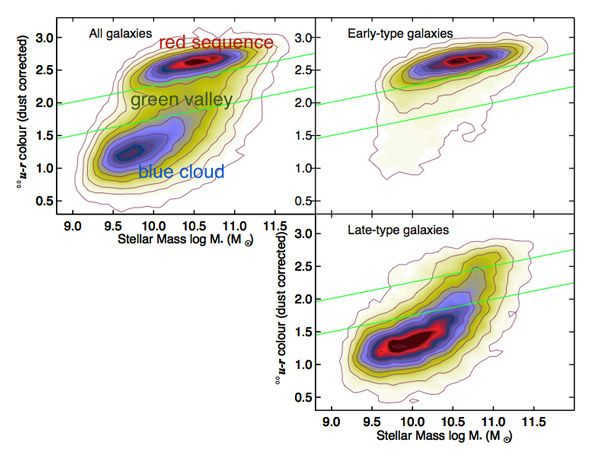
Figure 6. The arrangement of galaxies can be observed in the diagram that represents the relationship between color and mass. The vertical axis shows the color of galaxies, with lower values indicating bluer galaxies and higher values indicating redder galaxies. The horizontal axis represents the mass of stars in the galaxy, measured in decimal logarithms of the Sun’s mass. A value of 10.5 corresponds to a mass of stars equal to 10 to the power of 10.5 solar masses. Young galaxies with active star formation are located at the bottom of the diagram, while red, inactive galaxies are located at the top. The ultra-bright spiral galaxies discussed in this article can be found in the lower right-hand side of the diagram. Image sourced from blog.galaxyzoo.org
It has been discovered that a number of the extraordinarily bright spiral galaxies are actually part of clusters. These clusters vary in size, from the relatively small SDSS-CGB 49074 (which only has two members) to the massive CGCG 122-067, which contains 302 galaxies. Among these clusters, seven galaxies have been identified as the brightest (see Fig. 7). The brightest member of a cluster, also known as the Brightest Cluster Galaxy, must have been a part of the cluster since its inception. This means that it not only has to be incredibly old, but it also has to constantly be accumulating gas and dust, and it is highly likely to collide with smaller galaxies. Furthermore, the rotation at the center of hundreds of galaxies should have disrupted the spiral or disk structure due to tidal interaction. Therefore, the presence of these giant spiral galaxies in clusters poses a challenge to the current theory of cluster formation.
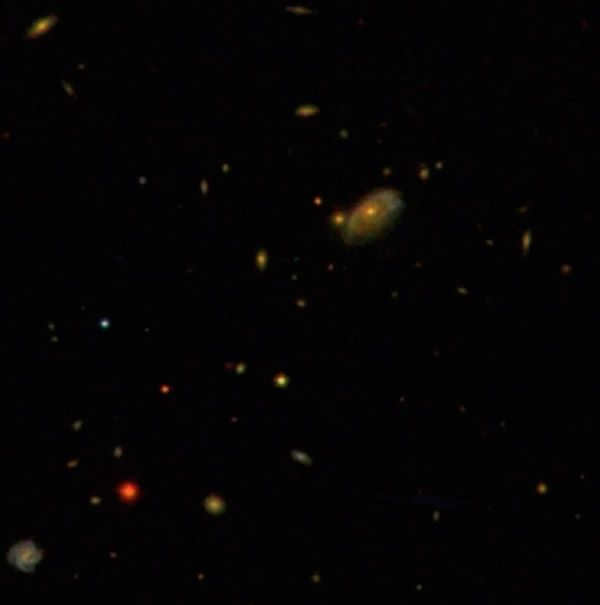
Figure 7. This is an incredibly luminous galaxy with a diameter of 90 kiloparsecs, which is equivalent to 294 thousand light-years. It can be seen just to the right and slightly above the center of the image. It is worth noting that this galaxy is the brightest and most massive in its cluster. In fact, almost all of the galaxies in the picture are part of this cluster. If you look closely, you can see how much larger the spiral galaxy is compared to each of the other galaxies. The optical image from the SDSS survey has a size of 579×579 kiloparsecs. This photo originates from the article discussed in The Astrophysical Journal.

